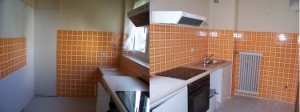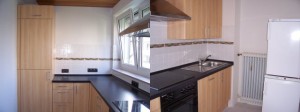And finally…
We are now getting settled in our new flat, but we still have one problem left to sort out: the old one!
You see, although we have given notice on our contract, unless we can find someone else to take it on we will be in that contract for the next few months. And that means paying both the rent and the mortgage – not something we really want to have to do.
The magic word here is “Nachmieter” – someone who will start a new contract before ours has ended and thus free us from it. We have been placing advertisements online and on notice boards for the last month and, although there have been several people come to see the flat, no-one has signed a contract yet.
On top of all that going on, we also have to redecorate it. Something that we want done by the end of September, so that theoretically new tenants could move in from the beginning of October.
So if you are looking for a flat with good connections to Frankfurt (the U-Bahn is just a short walk), then please get in contact with us!




